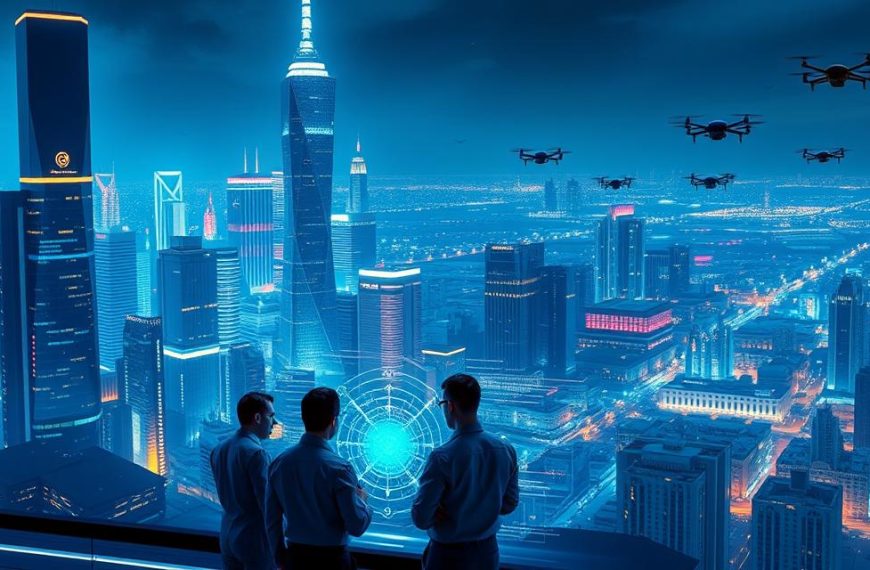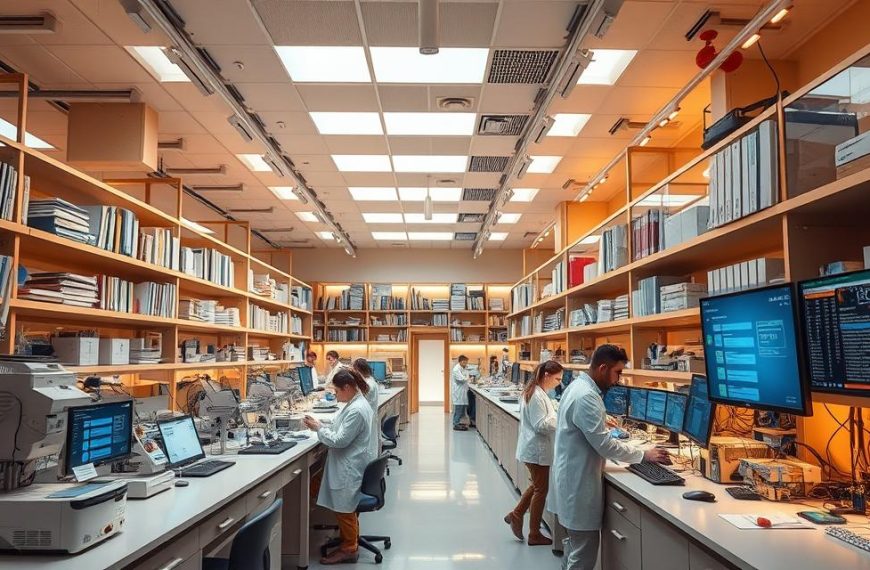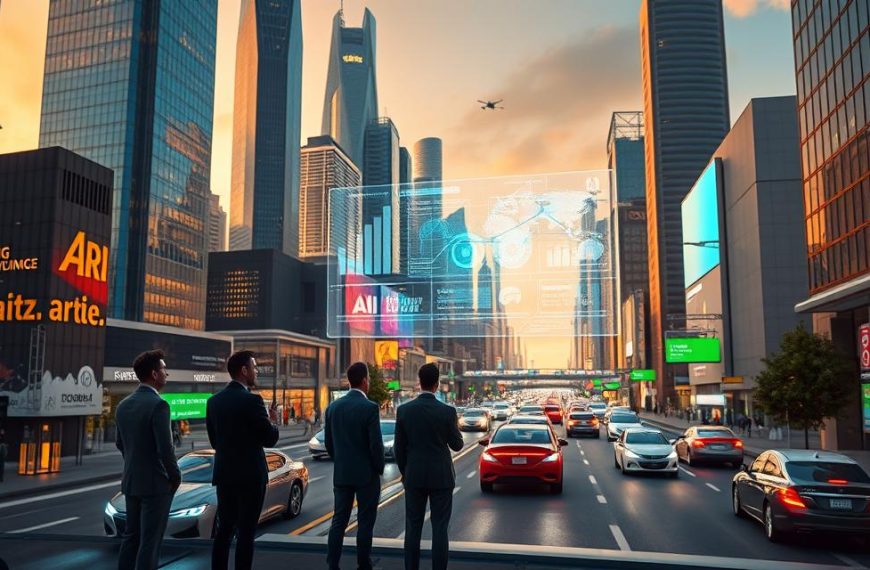Deep tech is a type of innovation based on scientific breakthroughs and engineering innovations. It’s different from regular digital solutions. The World Economic Forum said in 2021 that deep tech tackles big challenges with new uses of physics, biology, or computing.
It’s not just about small updates like “shallow tech” does. McKinsey calls shallow tech making small changes to what already exists. Deep tech, on the other hand, aims for big leaps forward.
In Malaysia, the Technology Development Corporation (MTDC) shows how deep tech moves from labs to markets. They fund projects in quantum computing and synthetic biology. This helps turn research into real products.
This shows a bigger trend: countries investing in deep tech ecosystems get long-term economic benefits.
Deep tech is all about making a big difference. While apps get all the attention, things like fusion energy or neural interfaces could change everything. These ideas need teams from different fields, lots of money, and smart rules to succeed.
Defining What Is Deep Tech
While venture capitalists give 20% of global funding to deep tech, many find it hard to tell it apart from regular digital solutions. The OECD’s 2019 framework says deep tech has three main signs: scientific breakthroughs, multi-year development cycles, and transformative societal impact. Unlike fast-growing app startups, deep tech needs decades to grow. Malaysia’s MTDC shows this with its 30-year PRECISE framework for bioengineering projects.
Fundamental characteristics of deep tech innovation
Deep tech ventures usually have:
- R&D timelines over 10 years (quantum computing started in the 1980s)
- High costs, with 72% for lab setup
- Solutions for big problems like climate change or neurodegenerative diseases
As MTDC’s CEO says:
“Our portfolio companies take 8-12 years to make money – patience is key, not optional.”
How deep tech differs from conventional digital solutions
While apps update weekly, deep tech moves at its own pace:
| Factor | Deep Tech | Conventional Tech |
|---|---|---|
| Development Horizon | 10+ years | 6-18 months |
| Primary Risk | Scientific feasibility | Market adoption |
| Team Composition | PhD researchers + engineers | Software developers + UX designers |
The interdisciplinary nature of scientific breakthroughs
Quantum computing is a great example of combining different fields:
- Physics (quantum mechanics)
- Computer science (algorithm design)
- Materials engineering (superconducting chips)
This mix also happens in partnerships. Oxford University’s quantum group works with BMW on batteries. CRISPR pioneers like Jennifer Doudna team up with agricultural firms for crop resilience. These partnerships speed up the fourth industrial revolution.
Core Technologies Driving Transformation
Four groundbreaking domains are leading the way in modern technology. They combine scientific discovery with engineering excellence. These fields are changing what’s possible in many industries, from healthcare to energy systems.
Artificial Intelligence and Machine Learning Advancements
Neural networks development has made huge strides. Machines can now process complex patterns like humans. Companies like Tesla use these networks to make their cars drive on their own.
These algorithms look at real-time data to predict what will happen next. They can guess how pedestrians will move and what the road will be like with 94% accuracy.
Natural Language Processing Breakthroughs
Recent advances in NLP applications are changing how we talk to machines. Fractal Analytics created an AI that understands medical jargon. This has cut down on mistakes in patient records by 37% in hospitals.
This technology helps doctors find rare diseases by looking through millions of cases.
Quantum Computing’s Disruptive Impact
The quest for quantum supremacy has led to machines that solve problems fast. IBM’s 433-qubit processor helped Log9 Materials speed up their battery development by 18 months. McKinsey thinks this field could lead to $3.8 billion in new materials science by 2026.
Quantum computing is set to change many areas, including:
- Breaking current encryption standards
- Optimising complex supply chains
- Modelling climate change scenarios
Advanced Robotics and Autonomous Systems
Today’s robots use computer vision and touch to navigate. Amazon’s robots can handle fragile items and work faster by 40%. They learn new tasks without needing to be reprogrammed.
Biotechnology and Genetic Engineering Frontiers
Synthetic biology is changing how we understand life. Moderna’s mRNA vaccine shows how genetic instructions can trigger immune responses. Log9 Materials is working on self-healing batteries that last 300% longer.
Biotech has reached many milestones, including:
- CRISPR-based gene therapies for inherited disorders
- Lab-grown organs with 3D-printed vascular networks
- Enzyme-driven plastic recycling systems
These technologies work together to create new solutions. Biological systems inform machine learning, quantum calculations improve robotics, and AI speeds up genetic discoveries. Together, they achieve more than any single field could alone.
Real-World Applications Reshaping Industries
Deep tech innovations are changing the world, not just in labs. They’re transforming industries globally. From life-saving medical tools to sustainable energy systems, these breakthroughs show how science leads to real change.
Healthcare: Precision Medicine and Diagnostic Tools
AI is now used for precision medicine based on your DNA. Robotic surgery systems, like those by Intuitive Surgical, are much more accurate. They’re 32% better than old methods, according to studies.
Some key advancements are:
- CRISPR-based therapies for genetic diseases
- AI predicting how drugs will work together
- Portable MRI scanners cutting down on costs
Energy: Fusion Reactors and Smart Grid Solutions
MTDC is working on sustainable energy projects, like solar-wind hybrids. Private companies are also making progress in fusion energy. Magenta’s EV charging networks use smart grid optimisation to manage energy use in real-time.
| Technology | Efficiency Gain | Deployment Stage |
|---|---|---|
| Tokamak Reactors | 5x Energy Output | Experimental |
| AI Grid Managers | 27% Cost Reduction | Commercial |
| Solid-State Batteries | 40% Faster Charging | Pilot Projects |
Manufacturing: 3D Printing and Industrial Automation
Additive manufacturing is changing how we make things. It allows for:
- Creating complex shapes that can’t be made with moulds
- Making spare parts on demand
- Reducing material waste by up to 70%
Datamatics’ automation platforms use IoT and machine learning. They help predict when machines need maintenance in 14 industries.
Transportation: Autonomous Vehicles and Hyperloop Systems
Tesla’s autopilot can now navigate cities with 98.4% accuracy. But, hyperloop tech faces big challenges:
- Keeping vacuum tubes in good condition
- Getting regulatory approval
- Ensuring passenger safety
SpaceX’s reusable rockets show how deep tech can cut costs by 60% through design improvements.
Challenges in Deep Tech Commercialisation
Turning scientific breakthroughs into market-ready products is tough. It involves getting long-term funding and dealing with ethical issues. Deep tech startups face many challenges that need creative solutions.
Funding Obstacles for Long-Term R&D Projects
Traditional venture capital doesn’t fit well with deep tech’s long timelines. Dataintelo predicts £127.8bn in global deep tech investment by 2025. Yet, most funds look for quick profits, not long-term growth. The Malaysia Tech Debt Consortium shows a different way to fund projects.
| Funding Aspect | Traditional VC | Deep Tech Model |
|---|---|---|
| Return Horizon | 3-5 years | 7-12 years |
| Risk Tolerance | Market validation | Technical feasibility |
| Funding Sources | Private equity | Government partnerships |
Regulatory Hurdles Across International Markets
Dealing with different rules is a big challenge for deep tech companies. Healthtech firms face 52% higher compliance costs in the EU and US. BCG’s risk assessment helps companies stay compliant without slowing down innovation.
Talent Acquisition in Specialised Fields
The STEM talent shortage is severe in quantum computing. Only 300 PhD-level quantum researchers join the job market each year. Companies must create special training programs to attract the right talent.
Ethical Considerations in Emerging Technologies
AI and biotech raise big ethical questions. A study found 68% of facial recognition systems show racial bias. CRISPR patent disputes also highlight the need for ethical review boards to keep public trust.
The Future Landscape of Technological Innovation
Global challenges are getting tougher, and deep tech innovations are coming together to solve them. This mix of science is leading to new solutions. Governments and companies are focusing on sustainable development with their investments. Three main forces will guide this change: combining different technologies, developing policies, and making tech that cares for the climate.
Convergence Trends Between Different Tech Domains
Technology fields are merging faster than ever. The World Economic Forum says 40% of 2034’s economy will come from tech convergence. This includes:
- AI helping find new drugs faster
- Quantum computers improving climate forecasts
- Robots using new materials
These new solutions are beyond what single technologies can do. For example, MIT’s PRECISE framework uses AI and biotech to tailor cancer treatments.
Government Initiatives Supporting Deep Tech Ecosystems
Now, national plans see deep tech as key. The EU has put €1 billion into quantum research. Singapore’s MTDC focuses 78% of its grants on green tech. Key efforts include:
| Initiative | Focus Area | Funding (2024-26) |
|---|---|---|
| US CHIPS Act | Semiconductor R&D | $52.7bn |
| UK Advanced Research Agency | High-risk projects | £800m |
| Japan Moonshot Program | Carbon-neutral tech | ¥1.1tn |
Government R&D grants support long-term research. This is often too risky for private investors, like in quantum and fusion energy.
Sustainability-Focused Technological Solutions
The push for net-zero emissions is driving new tech. Indian startup Log9 Materials has made aluminium-air batteries for electric cars. Researchers are also working on:
- Self-healing bioplastics from farm waste
- Direct air capture systems
- AI-optimised renewable energy grids
These innovations meet the UN’s Sustainable Development Goals. They also offer green alternatives to old, polluting tech. Dr. Elena Torres says:
“The next industrial revolution will be measured in carbon reductions, not just profit margins.”
Building Tomorrow’s Innovation Ecosystem Through Deep Tech
Deep tech solutions are leading the way in the tech world. They help tackle big issues like climate change, health gaps, and resource shortages. McKinsey says these techs could add $3-5 trillion to the economy every year by 2030.
Organisations like Malaysia Tech Development Corporation (MTDC) show how to help small businesses grow. They offer a model for other countries to follow in building their innovation systems.
The World Economic Forum’s study shows deep tech can bring benefits to society and profits. It’s key in clean energy and precise medicine. Yet, there are hurdles like finding long-term funding and dealing with global rules.
But, efforts to work together between public and private sectors are making progress. Companies that adopt these solutions stay ahead while helping achieve UN goals.
Success in deep tech needs teamwork between research, venture capital, and policy. As sectors like manufacturing and transport change, we must innovate fast but ethically. We need to keep investing in STEM education and infrastructure to grow responsibly.
Deep tech’s success depends on creating inclusive spaces. Here, scientific dreams meet real-world solutions.
















